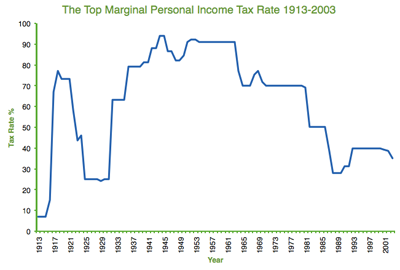A true flat rate tax is a system of taxation where one tax rate is applied to all income with no deductions or exemptions.
There are many proposed marginal flat taxes systems. Specific flat tax systems enumerated at the bottom of this article primarily intermix aspects of three high level approaches:
Modified flat taxes have been proposed which would allow deductions for a very few items, while still eliminating the vast majority of existing deductions. Charitable deductions and home mortgage interest are the most discussed exceptions, as these are popular with voters and often used. Another common theme is a single, large, fixed deduction; the concept here is that this blanket deduction rolls up a myriad of ubiquitous, fixed, living costs and has the simplifying side-effect that many (low income) people will not even have to file tax returns.
Designed by economists at the Hoover Institution, Hall–Rabushka is flat tax on consumption. Principally, Hall–Rabushka accomplishes a consumption tax effect by taxing income and then excluding investment. Robert Hall and Alvin Rabushka have consulted extensively in designing the flat tax systems in Eastern Europe.
The negative income tax system proposed by Milton Friedman in his 1962 book Capitalism and Freedom includes a flat tax. The system assesses a flat tax with personal deductions, except that when deductions exceed income, the taxable income is allowed to become negative rather than being set to zero. The flat tax rate is then applied to the resulting "negative income," resulting in a "negative income tax" that the government remits to the household (unlike the usual "positive" income tax, which the household owes the government).
In devising a flat tax system, several recurring issues must be enumerated, principally with deductions and the identification of when money is earned.
Since a central philosophy of the flat tax is to minimize the compartmentalization of incomes into myriad special or sheltered cases, a vexing problem is deciding when income occurs. This is demonstrated by the taxation of interest income and stock dividends. The shareholders own the company and so the company's profits belong to them. If a company is taxed on its profits, then the funds paid out as dividends have already been taxed. It's a debatable question if they should subsequently be treated as income to the shareholders and thus subject to further tax. A similar philosophical issue arises in deciding if interest paid on loans should be deductible from the taxable income since that interest is in-turn taxed as income to the loan provider. There is no universally agreed answer to what is fair. For example, in the United States, dividends are not deductible but mortgage interest is deductible. Thus a Flat Tax proposal is not fully defined until it differentiates new untaxed income from a pass-through of already taxed income. Taxes, in addition to providing revenue, can be potent instruments of policy. For example, it is common for governments to encourage social policy such as home insulation or low income housing with tax credits rather than constituting a ministry to implement these policies. In a flat tax system with limited deductions such policy administration mechanisms are curtailed. In addition to social policy, flat taxes can remove tools for adjusting economic policy as well. For example, in the US short term gains are taxed at a higher rate than long term gains as means to promote long term investment horizons and damp speculative fluctuation. Thus claims that flat taxes are cheaper/simpler to administer than others are incomplete until they factor in costs for alternative policy administration. In general, the question of how to eliminate deductions is fundamental to the flat tax design: deductions dramatically affect the effective "flatness" in the tax rate. Perhaps the single biggest necessary deduction is for business expenses. If businesses were not allowed to deduct expenses then businesses with a profit margin below the flat tax rate could never earn any money since the tax on revenues would always exceed the earnings. For example, grocery stores typically earn pennies on every dollar of revenue; they could not pay a tax rate of 25% on revenues unless their markup exceeded 25%. Thus corporations must be able to deduct operating expenses even if individual citizens cannot. A practical difficulty now arises as to identifying what is an expense for a business. For example, if a peanut butter maker purchases a jar manufacturer, is that an expense (since they have to purchase jars somehow) or a sheltering of their income through investment? Flat tax systems can differ greatly in how they accommodate such gray areas. For example, the "9-9-9" flat tax proposal would allow businesses to deduct purchases but not labor costs.. (And thus effectively tax labor intensive industrial revenue at a higher rate.) How deductions are implemented will dramatically change the effective total tax, and thus flatness, of the tax. Thus a Flat Tax proposal is not fully defined until it differentiates deductible and non-deductible expenses.
There are many proposed marginal flat taxes systems. Specific flat tax systems enumerated at the bottom of this article primarily intermix aspects of three high level approaches:
Modified flat taxes have been proposed which would allow deductions for a very few items, while still eliminating the vast majority of existing deductions. Charitable deductions and home mortgage interest are the most discussed exceptions, as these are popular with voters and often used. Another common theme is a single, large, fixed deduction; the concept here is that this blanket deduction rolls up a myriad of ubiquitous, fixed, living costs and has the simplifying side-effect that many (low income) people will not even have to file tax returns.
 a triple-rate flat tax. | The Pros of a Flat Tax System |  \x26quot;A flat tax (short for flat |  Tax System Problems and Flat |  Editorial: Flat tax working in the real world |
 with flat-rate tax systems |  Why the Flat Tax is Efficient. Table I - Effective Tax Rate on Capital in | This great tax shift is |  Is a flat tax rate the answer? | TAX SYSTEM TO A FLAT TAX |
In devising a flat tax system, several recurring issues must be enumerated, principally with deductions and the identification of when money is earned.
 That sounds like a flat tax |  Why we Need a Flat Tax Rate |  a flat tax rate |  a simple flat tax rate |  A flat tax is a universal tax |
 Should the entire system of |  flat-rate tax system. |  The flat tax system, |  The flat tax |  Kosovo Base Maps |
No comments:
Post a Comment